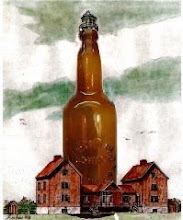by_J.Vorel_ As the craft beer market continues to expand and the number of brands on the shelves continues to rise exponentially, one of the most overlooked issues generated by that growth tends to be freshness of the product. It's become the white elephant of beer retail: A lot of the product is way past freshness, and in some cases there's not even any way for the consumer to tell.
This is one of the nicer things about having a new package store open in your town. At a newer store, you're going to be much less likely to see old product clogging up the shelves. But as more time goes by, you have to keep your eyes open. Case in point: I was browsing the large format bottles section for new releases. As I looked through a number of 22-ounce beer bottles, I was shocked by the freshness dates I was seeing. Six months or a year old is bad enough, but there were IPAs sitting on that shelf that were brewed in 2011, and others made in 2012. They were easily the oldest IPAs I've ever seen that were still being offered for sale. They weren't even discounted, or placed in the display for old or out-of-season beers.
Bear in mind, these are mostly products designed to be consumed within a few months of their arrival. The reason for hop-forward beer in particular has to do with oxidation and the gradual breakdown of delicate aroma and flavor components derived from hops. In general, hoppy beer degrades faster than other varieties in its overall flavor profile, losing a lot of its freshness and signature characteristics within a few months. As the months stretch on after that, negative “off-flavors” tend to emerge, which often range from “cardboard” to “skunk” or Robitussin-like medicinal flavors. All of these processes are accelerated by several things they're regularly exposed to in stores, including room-temperature storage and fluorescent lighting.
So why does beer end up on shelves past freshness? Unfortunately, it's a byproduct of craft beer's great success. As more and more breweries are opened and the shelves are crowded with new product, even longtime favorites can get edged out by the new guy in town. Minimum order sizes from distributors are also a factor, and possibly an unrealistic one. After all, the more breweries there are for a retailer to stock, the less beer from each individual one they can probably buy, right? Being handcuffed to a minimum order is something retailers no doubt regret once they're sitting on a few cases of past-fresh IPA.
What this means for us, the consumers, is that it's now more important than ever to pay attention to beer freshness dating. Many breweries now include this information somewhere on the label, cap or the bottle itself, but the lack of industry standardization can be very frustrating. Some have steadfastly resisted printing “born on” or “drink by” dates, making it impossible to know how old the product is, or hide the date in coded numbers that only the distributor can deduce. Others have gone in the exact opposite direction, raising awareness of the issue with products which are specifically designed to be consumed by a set date. It also makes it quite obvious when a past-date “Enjoy By” bottle is sitting on the shelf, and I wish I could say that was only a hypothetical, but I've physically seen that happen as well.
What this also means for consumers is that we all need to be a little more proactive in requesting fresh beer and pointing out stuff that is past its prime. If you see a hop-forward beer that is a year old sitting on shelves, tell someone at the store. If an IPA doesn't have any kind of freshness dating at all and you don't know how long it's been there, ask someone at the store if they know. They'll more than likely be able to give you that information or look it up. And if it seems clear that the retailer isn't committed to cycling out the past-fresh product, there is one last place you can take that information: To the breweries themselves. Craft brewers hate to hear stories about their past-fresh product still being in circulation because it's inherently bad for their business. A brewery stands to lose a customer immediately if someone buys their three-year-old IPA and turns up his nose at a stale or gross-tasting product. Contacting someone at the brewery can send a ripple effect through the distributor and all the way back to the retailer.
As even more breweries expand distribution into your market, this issue will only become more prevalent. Please join in pushing for the freshest possible product. Good beer is worth searching through a few best-by dates.
Wednesday, March 12, 2014
Subscribe to:
Post Comments (Atom)



No comments:
Post a Comment